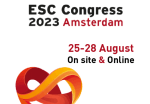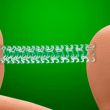The empirical prescription of anticoagulants after percutaneous coronary intervention (PCI), also know as post-procedural anticoagulation (PPA), is nowadays a common practice that uses various types of medications. Despite studies like HORIZONS-AMI and EUROMAX, in which 41% of patients received PPA, and the CCC-ACS registry, where 75% of subjects received PPA after primary PCI, European and<a href="https://solaci.org/en/2023/08/30/esc-2023-anticoagulation-after-primary-pci-in-stemi-patients/" title="Read more" >...</a>
ESC 2023 | STOPDAPT-3
Short Dual antiplatelet therapy (DAPT), one to three months, followed by P2Y12 inhibitor monotherapy has been shown to reduce bleeding events without increased cardiovascular events vs. standard DAPT, according to guidelines. However, the rate of major bleeding within the first month after procedure remains significant when using these strategies. The use of aspirin-free therapies (ASA)<a href="https://solaci.org/en/2023/08/29/esc-2023-stopdapt-3-2/" title="Read more" >...</a>
ESC 2023 | OCTOBER TRIAL: Should We Begin to Consider OCT for Bifurcation Lesions?
The OCTOBER Study randomized 1201 patients with bifurcation lesions in a 1:1 ratio to undergo percutaneous transluminal coronary angioplasty (PTCA) guided by optical coherence tomography (OCT) or by angiography. The primary endpoint (PEP) was major adverse cardiovascular events (MACE) over a 2-year period. Group characteristics were similar. The average patient age was 66 years, most<a href="https://solaci.org/en/2023/08/29/esc-2023-october-trial-should-we-begin-to-consider-oct-for-bifurcation-lesions/" title="Read more" >...</a>
MACT Study: Monotherapy with P2Y12 Inhibitor Associated with Colchicine after Acute Coronary Syndrome
Dual antiplatelet therapy (DAPT) is the current standard for preventing thrombotic events in high-risk patients with coronary artery disease, as well as in patients with acute coronary syndrome (ACS) undergoing percutaneous coronary intervention (PCI). However, this approach increases the risk of bleeding. To reduce this risk, there have been studies that discontinued the use of<a href="https://solaci.org/en/2023/08/29/mact-study-monotherapy-with-p2y12-inhibitor-associated-with-colchicine-after-acute-coronary-syndrome/" title="Read more" >...</a>
Long Term Outcomes after Complex PCI According to Operator Experience and Use of IVUS
The use of intravascular ultrasound (IVUS) to guide percutaneous coronary interventions (PCI) has been shown to reduce the risk of major adverse cardiovascular events (MACE) across controlled randomized studies, registries and meta-analysis. Current guidelines recommend the use of IVUS in left main disease and complex lesions. As the prevalence of complex PCI increases over time,<a href="https://solaci.org/en/2023/08/16/long-term-outcomes-after-complex-pci-according-to-operator-experience-and-use-of-ivus/" title="Read more" >...</a>
EuroCTO: Safety and Benefit at 3 Years
Chronic total occlusions (CTOs) account for approximately 15-20% of patients with stable coronary artery disease. This field has seen various advances regarding treatment, leading to an improvement in the success rate of procedures. According to registries and randomized studies, the main indication for percutaneous coronary intervention (PCI) of CTO should be based more on clinical<a href="https://solaci.org/en/2023/07/24/eurocto-safety-and-benefit-at-3-years/" title="Read more" >...</a>
SCOPE I Results at 3 Years: ACURATE Neo vs. SAPIEN 3
Transcatheter aortic valve implantation (TAVI) has become the standard treatment for elderly patients with severe symptomatic aortic stenosis. While this has led to the development of new devices with different features, evidence from randomized studies on these new scaffolds is limited. The randomized SCOPE I study (Safety and Efficacy of the Symetis ACURATE Neo/TF Compared<a href="https://solaci.org/en/2023/07/24/scope-i-results-at-3-years-acurate-neo-vs-sapien-3/" title="Read more" >...</a>
ABSORB IV – Improving Bioresorbable Scaffolds: A Long Road
5-year followup of bioresorbable scaffolds in selected and better prepared lesions (ABSORB IV). Historically, when comparing previously used therapies, such as conventional balloon angioplasty (BA) against bare metal stent (BMS) and later against drug eluting stent (DES) implantation, we see significantly improved outcomes. These advances have shown reduced recoil and more effective restenosis inhibition, compared<a href="https://solaci.org/en/2023/07/19/absorb-iv-improving-bioresorbable-scaffolds-a-long-road/" title="Read more" >...</a>
No Reflow after Primary PCI in STEMI: An Angiographic Analysis of the TOTAL Study
In the early days of percutaneous coronary intervention (PCI) in patients with ST elevation acute myocardial infarction (STEMI), no reflow phenomenon was known as an indicator of the worst possible outcomes in terms of left ventricular remodeling, infarct size, ejection fraction and mortality, at long term. The TOTAL study (Routine Aspiration Thrombectomy with PCI Versus<a href="https://solaci.org/en/2023/07/17/no-reflow-after-primary-pci-in-stemi-an-angiographic-analysis-of-the-total-study/" title="Read more" >...</a>
Secondary Prevention with P2Y12 Inhibitors: How Consolidated Is This Long Term Alternative vs. Aspirin?
Secondary prevention with P2Y12 inhibitors vs aspirin monotherapy in CAD patients Antiaggregation therapy plays a central role at long term to prevent new cardiovascular events in atherosclerosis patients. After repeat myocardial infarction (MI) or stroke, prognosis can vary considerably. Even though the current guidelines prefer aspirin as the first choice for secondary prevention over P2Y12<a href="https://solaci.org/en/2023/07/13/secondary-prevention-with-p2y12-inhibitors-how-consolidated-is-this-long-term-alternative-vs-aspirin/" title="Read more" >...</a>







